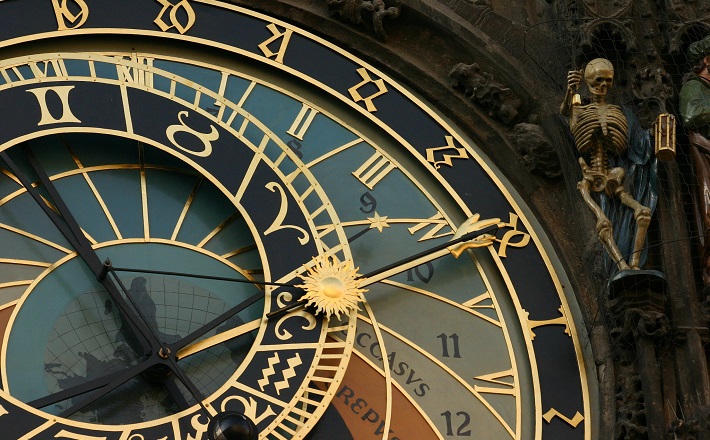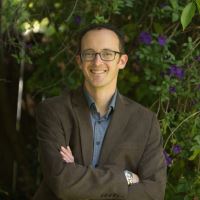Commentary on Romans 13:11-14
This week is the first Sunday of Advent, the first Sunday of the new year in the church calendar.
The season of Advent is a season of waiting; as a time of waiting it is a time of preparation. We prepare ourselves for the coming of Christ.
When we talk about “the coming of Christ,” we’re not just talking about the birth that we will celebrate in a few weeks’ time. In Advent, we see the coming of Christ in double-exposure: looking forward to the second coming of Christ in the future even as we look forward to celebrating the first going of Christ that lies in the past. It is as though the liturgical year allows for the two defining moments of our age, its beginning and its end, to overlap in a mystical time that is simultaneously past, present, and future.
Know What Time It Is
Understanding that Advent is as much about preparing for the yet-to-come arrival of Christ as it is about the already-past arrival of Christ is critical to understanding why we kick off Advent with Romans 13:11-14 as one of our Lectionary texts.
In fact, Romans 13:11 begins with the exhortation, “Know what time it is!” (NRSV). The time Paul has in mind is the pregnant eschatological moment that began its gestation with Jesus’ life, death, and resurrection and will have its full birth at his return.
One of the beauties of Advent’s double-exposure is that it reminds us that God answered the people’s long-suffering anticipation of the Messiah’s birth, thereby providing us with renewed hope that the long-anticipated return of the Messiah is also something we can continue to hope for.
The Night is Gone, the Day is At Hand
The imagery we use in our Advent services reflects the imagery of dawning light Paul uses in Romans 13:12-13. He speaks of the night being far gone, and the day of salvation being at hand. The implication he draws is that we need to live properly, as in the day.
The notion of a dissipating darkness is one that we model each Sunday as we light one additional candle, right up to the point where we light the Christ candle, signifying simultaneously the moment when the Light of the World was first born upon the earth and our hope that the Light of the World will once again come and cast away every shadow of darkness. Advent is a season of hope: hope that God’s promised future will, in fact, arrive again as it did on the first Christmas.
Living as People of the Day
The fact that the light has already begun to shine, that Christ has already been born, that Christ has already enacted our salvation, should not be ignored in this season. On the contrary! Paul here says that to live properly in this season of dawning light is to “put on the Lord Jesus Christ.” The season between the first and second Advent of Christ is one in which Christ’s advent to the throne at God’s right hand offers us the possibility of living now as creatures of the new creation yet to come.
In essence there are three sources of hope for the promised future: (1) the promise Christ made that he would return; (2) Christ’s own resurrection which shows us that there is an embodied future on the new creation awaiting us; and (3) the transformation of our lives and communities here and now, which is a manifestation of the future that awaits us.
So, we wait for Christ’s coming by becoming the Christ people: putting off the deeds that mark the world not subjected to Christ’s reign of peace and justice. We wait for Christ’s coming by becoming that future ahead of his arrival, so that when he arrives he will behold his own as though looking in a mirror.
This is why Paul says at the beginning to “waken from sleep.” It is a summons to start faithfully living out the resurrection-life of Christ.
Deeds of Darkness?
As Advent signals a time of rising joy and expectation, we might be more skittish than usual about dropping the “s”-word (sin) in church. We like talking about brokenness and injustice is all in vogue. But the word “sin” has fallen on hard times. Some of us want to give Romans 13 a wide berth on the first week of Advent because of its talk about putting off revelry and drunkenness and debauchery and licentiousness and quarreling and jealousy.
And yet, the idea that there is a bright future to take hold of means that there is a night to be left behind — including the night in ourselves. Our own brokenness overflows beyond ourselves in ways that wound others. Our brokenness leads us to act in ways that further wound ourselves. I think both of these are ideal candidates for the “s”-word.
Perhaps Paul is inviting us, this Advent, to put on the Lord Jesus Christ by doing a little experiment. Perhaps each of us might imagine a Jesus-looking opposite to one temptation that the “holiday season” of our world will confront us with: How might I put on gratitude rather than succumb to jealousy? How might I be peaceable with my family over the holidays rather than following into the same old patterns of quarreling? What might sobriety offer me at that party where I’m tempted to have one or two drinks too many?
Perhaps taking such steps would open us up to our true selves. Perhaps these would be little rays of light piercing the darkness of our false selves. Perhaps in these ways we might put on the Lord Jesus Christ and bring a little bit of his future into our present time of waiting and preparation.


November 27, 2016